This blackened salmon brings a huge punch of flavor and the entire meal comes together in under 30 minutes. It’s sweet and spicy from the blackening spice, with an acidic and creamy fruit salsa to tame the fire.
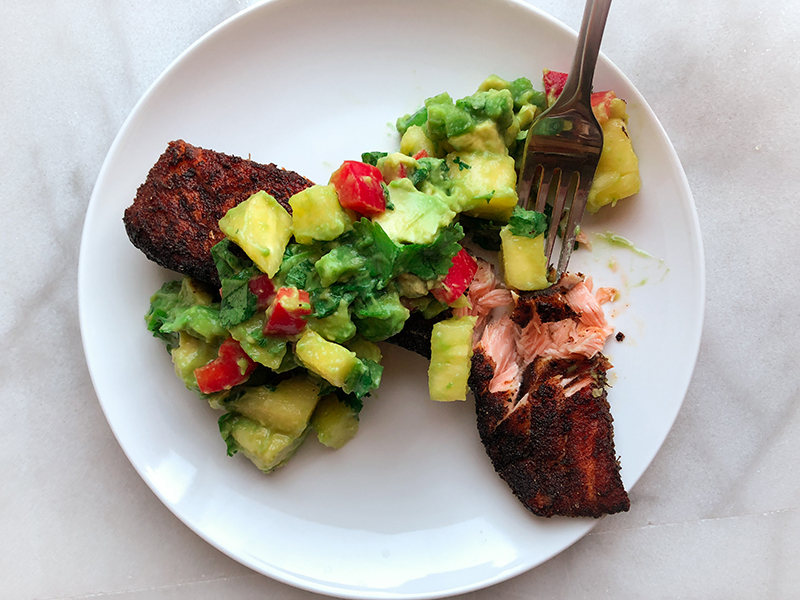
This recipe paired with the fruit salsa is so good, you guys. I make it for just the two of us (I usually make the full spice recipe and just save half in a baggie for next time) pretty frequently, but I also love to pull it out for company because it’s fast, it tastes impressive, and there’s minimal fish stink in the house afterwards.
If you’re intimidated by cooking fish, I’ve got you covered. Get a non-stick pan and an instant read thermometer and you’re on your way to perfect fish every time. Pinky promise. (Also read the full post and recipe because I’ve got lots of tips and advice for you! But you were going to do that anyway, right?)
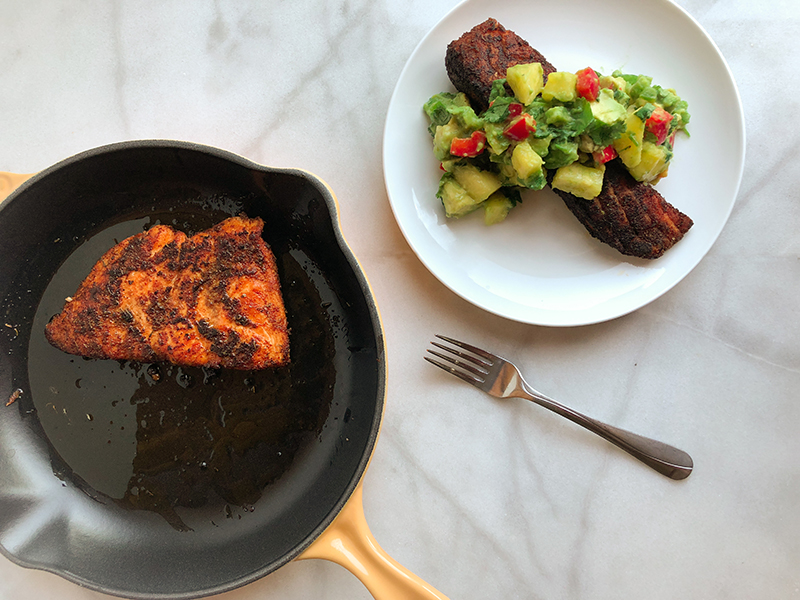
Also, yes, I know it’s fall and most people don’t think of blackened fish when they think of fall, but good food is good all year round, in my opinion. Or, you know, save it and come back to it when you’re feeling summery. Whatever you want. I can wait.
I’ll admit, I wouldn’t touch fish as a kid and it wasn’t until I was in culinary school that I actually realized I liked salmon. However, it wasn’t really until we made blackened fish that I fell in love with it enough to make it at home. Now I LOVE having frozen salmon fillets on hand because they thaw quickly and cook even faster which is ideal for my short attention span.
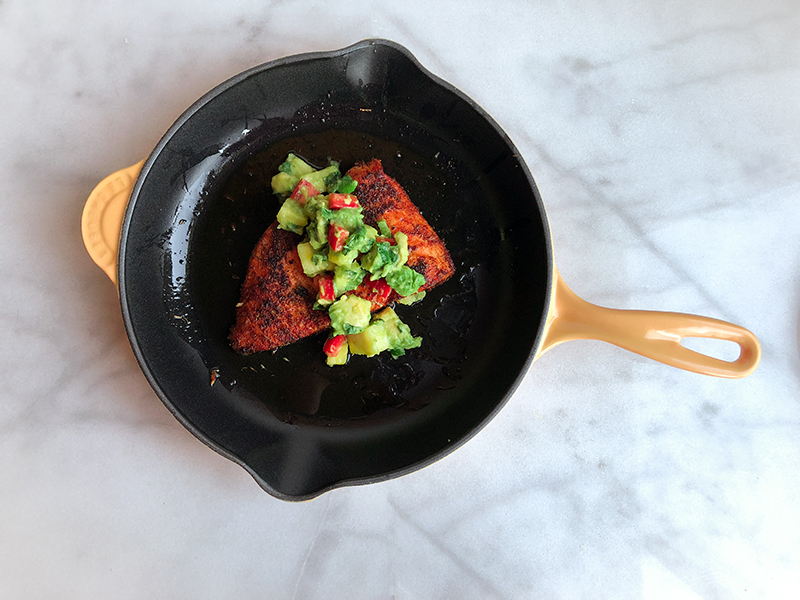
This recipe is spicy, so if you love the blackened flavor but hate lighting your mouth on fire then you can tone down the cayenne pepper. I would mix it into the blackening spices 1/4th teaspoon at a time and taste, stopping when it’s the right spice for you. If you’re the type of person who starts out at a level 11 spicy at every restaurant, you can replace some of the paprika with cayenne pepper. You do you, basically.
This basic recipe would be excellent for Mahi Mahi or even chicken. (But make sure you follow the correct temperature guidelines for the type of protein you’re using (just Google it!) because a safe temperature for salmon is NOT a safe temperature for chicken.)
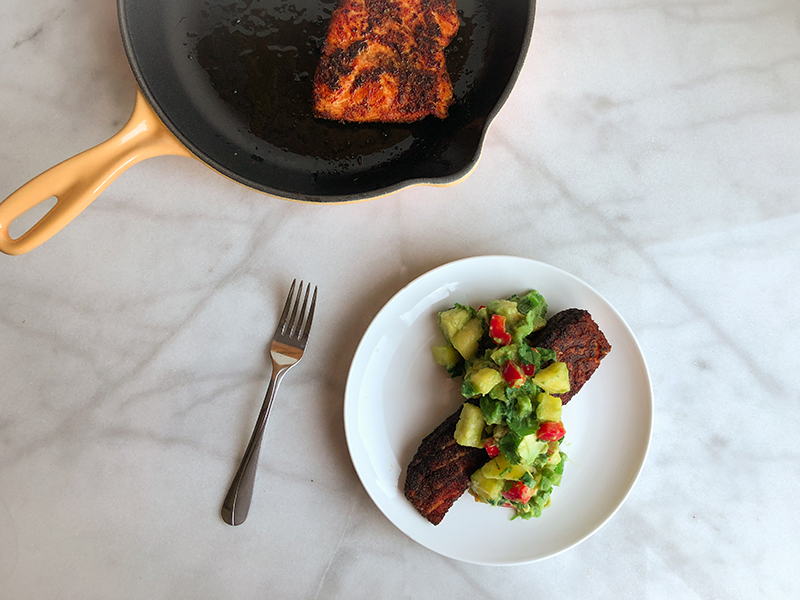
A note about safety and doneness: You will want an instant read thermometer for this recipe because it is the fastest and most reliable way to tell when fish is done. Check the temperature of the fish by inserting the thermometer probe into the middle of the thickest part of each fillet. This recipe instructs you to cook to an internal temperature of 135-145 degrees F. 135 is medium rare/medium well which is how I like my salmon. 145 is well done, and is recommended by the USDA. Salmon does not need to be cooked to death to be safe (remember sushi grade fish can be eaten raw, but DO NOT do this unless your fish is definitely sushi grade because fish intended for sushi is always frozen down to a specific temperature to kill any parasites), but if you’re not 100% sure where your salmon came from or how it was handled, cooking to 145 is the safest option. However, to prevent overdone salmon, I recommend pulling it out of the oven at exactly 140 degrees, because carryover cooking will bring it up to 145, and salmon goes from perfect to overdone in a snap.
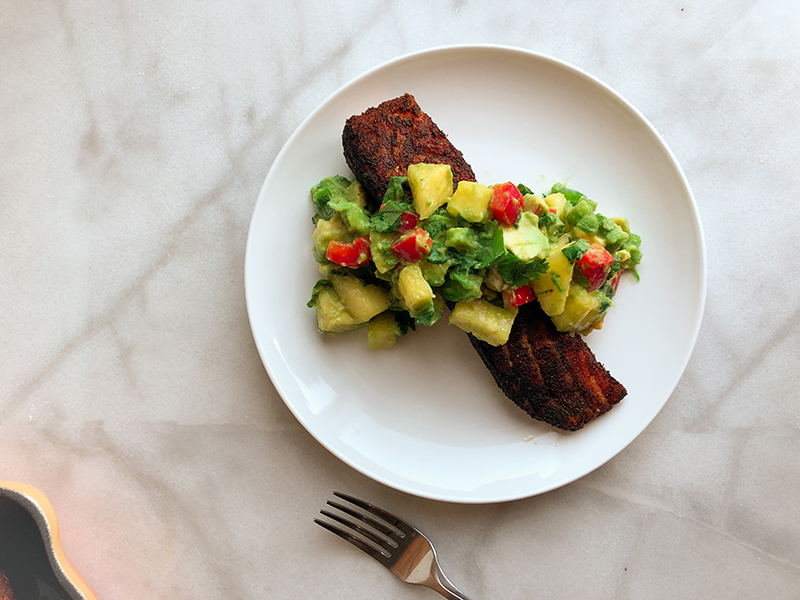
Ready to make this recipe? Here’s the printable recipe card!
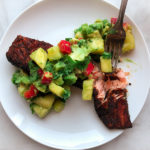
Blackened Salmon with Pineapple Avocado Salsa
This blackened salmon brings a huge punch of flavor and the entire meal comes together in well under 30 minutes. It’s sweet and spicy from the blackening spice, with an acidic and creamy fruit salsa to tame the fire.
Ingredients
Blackened Salmon
- 4 salmon fillets skinless
- 2 tablespoons neutral cooking oil I like peanut
- 1 tablespoon onion powder
- 1 tablespoon paprika
- 1/2 tablespoon kosher salt I use Morton’s
- 1 tablespoon granulated sugar
- 2 teaspoons black pepper
- 1 teaspoon ground oregano
- 1 teaspoon thyme
- 1 teaspoon garlic powder
- 1 teaspoon cayenne pepper
Pineapple Avocado Salsa
- 2 ripe avocados diced
- 1 cup diced fresh pineapple about 1/2 of a pineapple
- 1 red bell pepper diced
- 1 jalapeno minced, seeds removed
- 1 lime juiced
- 1 tablespoon brown sugar
- 1 teaspoon kosher salt I use Morton’s
Instructions
-
Preheat oven to 375 degrees F.
-
Mix all of the Pineapple Avocado Salsa ingredients together in a bowl. Taste and adjust the sugar, salt, or lime juice if you need to. Cover and set aside.
-
Heat oil in a large oven safe* non-stick or well seasoned cast iron pan (don’t use a pan you don’t 100% trust for fish or you may end up with all that beautiful seared crust stuck to your pan) over medium high heat.
*If you don’t have an oven safe frying pan, you can preheat a baking sheet with the oven and carefully transfer your salmon onto that after searing later on in this recipe.
-
Mix all of your spices (including the sugar and salt) together in a bowl and set aside. Pat your salmon fillets dry with a paper towel and then coat them in the blackening spice. You want them completely covered on all sides like you’re applying a barbecue rub.
-
Once your pan is very hot, add the salmon and sear, about 1.5 minutes per side or until there is a nice dark, but not burnt, crust on each side of the salmon.
-
Transfer your salmon to the oven and cook until the internal temperature reads 135-145 degrees F (see notes about doneness), 5-10 minutes.
-
Serve immediately topped with the Pineapple Avocado Salsa.
Recipe Notes
You will want an instant read thermometer for this recipe because it is the fastest and most reliable way to tell when fish is done. The recipe instructs you to cook to an internal temperature of 135-145 degrees F. 135 is medium rare/medium well which is how I like my salmon. 145 is well done, and recommended by the USDA. Salmon does not need to be cooked to death to be safe (remember sushi grade fish can be eaten raw, but DO NOT do this unless your fish is definitely sushi grade because fish intended for sushi is always frozen down to a specific temperature to kill any parasites), but if you’re not 100% sure where your salmon came from or how it was handled, cooking to 145 is the safest option. However to prevent overdone salmon, I recommend pulling it out of the oven at exactly 140 degrees, because carryover cooking will bring it up to 145, and salmon goes from perfect to overdone in a snap.
Do you see albumin or “white fat” coming out of your salmon? This is a globular protein and it’s completely harmless. Some people think this is a sign of overcooked fish, but don’t worry, it’s not. If it bothers you, just wipe it off before serving.

Leave a Reply